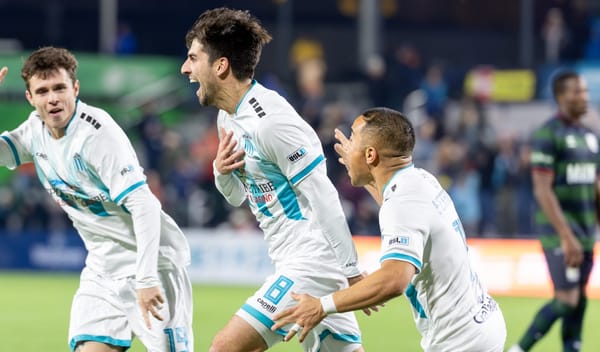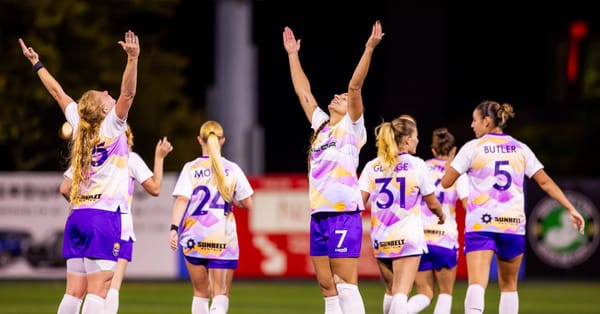In Conversation: Andrew Swanson, Edgewater Castle FC
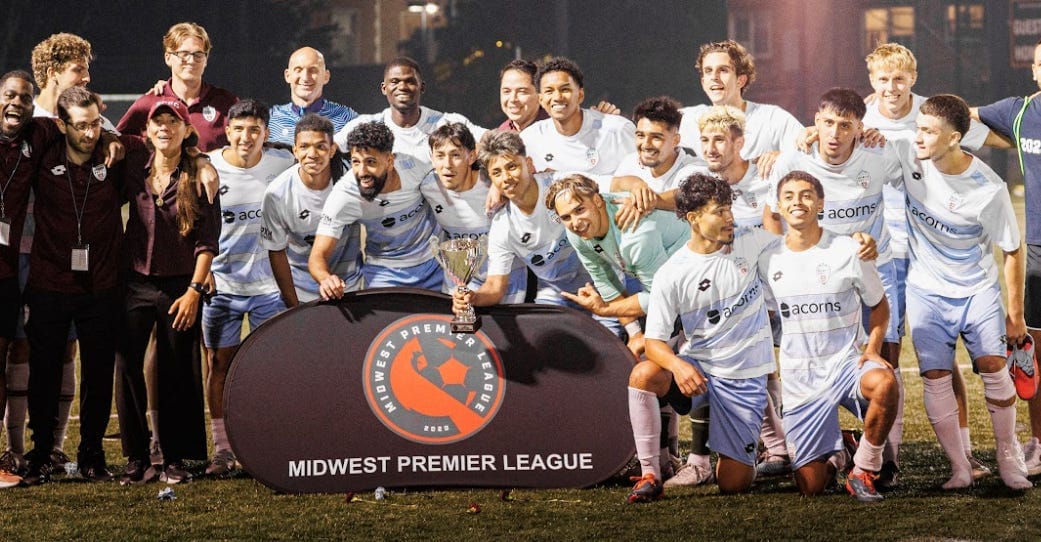
USL League Two and the USL W League are among the fastest-growing sports organizations in America, if not the world. With nearly 250 clubs dotted across the map, those competitions play a major role in making soccer accessible at a grassroots level.
For mission- and community-oriented clubs across the country, the USL’s pre-professional divisions provide a platform that maximizes local impact and on-field competition. Clubs like Vermont Green and Minnesota Aurora have earned national headlines for their efforts in 2025, and now Chicago-based Edgewater Castle FC is aiming to do the same.
As Edgewater Castle prepares to move up the pyramid next season, club president Andrew Swanson sat down with USL Tactics to discuss their mission, Kellyn Acosta’s involvement, and what comes next.
For those of us who are less familiar with the project, introduce us to Edgewater Castle FC – the mission you’re trying to embody.
Edgewater Castle Football Club was started in 2017 as a neighborhood-based charity, essentially. It was co-founded by myself and James Kitia, who’s also in the community and has much more of a background in soccer than I do. The mission from the very start was to provide the low-income immigrant and refugee communities of our area with free access to the game – whether they be kids who need something to do after school, high school and older players that need coaching and want to continue to play.
We tried to create an environment that was purely accessible, both financially and culturally, and that became our core value. We’ve evolved a lot as a club and a business. We now have an LLC and a non-for-profit wing. The nonprofit now focuses exclusively on free youth access to the game, as well as free adult pickup playing opportunities in the community. The LLC is now exclusively focused on the men’s and women’s programs and their shift toward more elite, professional levels of the game here in the US.
The truth is, the accessibility and value that we offer right now is commensurate to the level we’re at. We have a really good foundation, and now we’re moving toward the future. Our values are very real for us. This part of Chicago – Edgewater, Uptown, Rogers Park – is home to over 70 languages spoken, right? There are people here from literally every corner of the world, and that’s a beautiful thing. It’s very much a part of the identity that we’re celebrating with the brand and with the club.
The pay-for-pay model is all over the place in American youth soccer, and it’s pervasive in terms of limiting access for people with less resources. Can you talk about pay-for-play and how your club is trying to build something different in Chicago?
It’s a problem for a number of reasons, right? It’s a large, longstanding ecosystem problem. The biggest answer, really, is that [pay-for-play] has become a very dependable industry. If you say you’re involved in soccer, everyone mentions how lucrative youth soccer is – but that isn’t going to drive the culture or establish soccer in this country. I don’t think it’s going to provide access to the best players based on meritocracy, because there are financial barriers for families and kids where talent has nothing to do with that.
I’m not a person who’s like, “All pay youth soccer clubs should disappear,” right? I don’t think that’s a realistic answer. I think there needs to be a broader scope with different kinds of youth clubs. For us, the biggest thing that we’ve always tried to do is not sacrifice the mission. At every level – our adult amateurs, all of our youth programming, any pickups we do – it’s all free. People can donate to the nonprofit if they want, but nothing is required to participate in any of our programs.
We’ve had to put in the hours, put in the volunteer time to get the support of the community and get people who want to build an ecosystem with the civic organizations in Chicago. We work really closely with the Chicago Park district. We’ve got good relationships with a lot of the schools in the area, including the [Chicago Public School system] and their athletics. Over the years, we’ve built a lot of goodwill among these organizations.
It’s a symbiotic relationship that took a really, really long time to foster. Before we even founded the club, I was working with the park district and other projects in the arts, navigating the bureaucracy and red tape that takes a lot of time and patience.
On top of that, it’s James [Kitia]. James has been at hundreds and hundreds of practices throughout the last eight years. Now, between interns, volunteers, contracted staff, and part-time staff, we have almost 40 people who are around on an annual basis working on this thing. That is very different from a couple years ago. The way it was even possible was through people being willing to be patient and work really hard on it.
It comes through that you needed to lay a lot of groundwork and build a lot of infrastructure to fill a specific niche that wasn’t being met in Chicago. Do you feel like that was the case?
It’s a cliche at this point, but it was a “see a need, fill a need” situation. I didn’t know a ton about soccer, frankly, when this all started. I’m pretty new to the game; I started to get interested around late 2016 and it very quickly evolved into a bit of an obsession. What I did see was that I lived in a community that’s very globally representative and very proud of that. The way to celebrate that had always been through the arts and through theater – shout out Jackalope Theater, also here in Edgewater!
There’s a continuous need for more engagement with the community. We’re trying to adjust and evolve both sides of the club to continue to meet that need. There aren’t a lot of sponsored programs out there. I know that [the American Youth Soccer Organization] is a very large, national organization, and the region of AYSO up here is really, really big and successful. There are accessible ways to get involved in that stuff, too.
I think that coming in as a club that says, “At every level, it’s pure meritocracy and no money is going to be asked of you,” is new here. It’s not always the case across amateur soccer and youth soccer, certainly. Continuing to be kind of steadfast in our values and what we stand for here is really, really important – especially now in Chicago. As we’re moving into the different realms of the game and professionalizing more and more, everything starts to feel like it’s changing. But shifting away from that mission is something that we can’t compromise.
Turning to the senior side, what made this the right moment to move up to USL League Two and the W League?
It was a big combination of things. We’ve had pretty steady growth over the years, but at no point did it feel like we were reaching the top of our ceiling until this past season. We took another big step up in terms of the performance on the field from our men’s and women’s teams. The men brought home the Illinois State Cup and got promoted in Midwest Premier League, and the women won the Illinois State Cup as well and the Midwest and National [United Women’s Soccer] Championship in 2025. We brought home five trophies.
All of the staff and coaches were really, really dedicated and committed to the project being successful. Our recruitment has gotten much, much better in the last year or two. Basically, we were able to bring together a group of leaders at the club who really solidified the foundation. We moved into a bigger stadium. We got a glimpse of what being successful in a level more like League Two and W League would be.
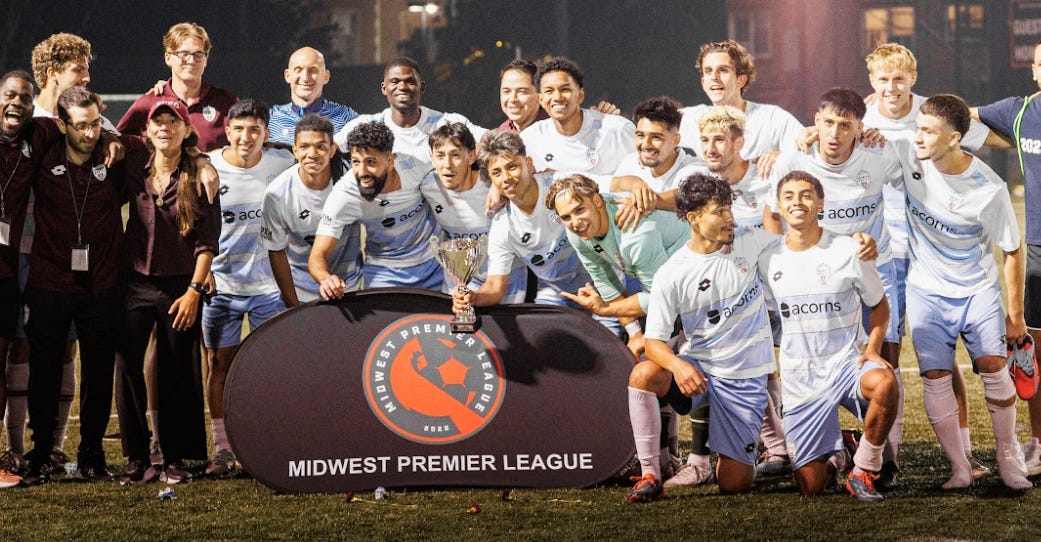
The moment came where we started to get support, bigger sponsors, and things like that. All of the different plates were spinning, and it looked like we could handle it. We obviously brought the idea to the sporting side, we brought it to the coaches and the rest of the staff and said, “What do y’all think? Do we think this is something that makes sense?” Everyone agreed that it’s a challenge, but it’s one we want.
We’ve always been pretty ambitious, and we’ve always wanted to climb. Part of the excitement is challenging yourself to try and get further along. Soccer is pretty obviously suited for that globally, right? Storytelling-wise, that’s built into the culture of the game, which we all would love to see more of here.
We started to get some more minority owners on board, get more investment in the LLC, communicating with them and our board of directors to get everyone’s idea of what we really think we can do. Long term, we want to keep evolving and getting better and bigger while retaining those values and that mission. That’s very much the dream for us.
Getting down to brass tacks, I think people lack awareness of what it looks like to actually join the USL at a club level. There are timelines, standards, all those requirements, but can you take us through that process?
They’re a very large organization! They have a ton of teams in their pyramid, a ton of bigger brands than us, and they have very lofty plans – as we all know. The USL is very on top of it. They want to hear what you have to say, and they want to know everything they can about your club, right? I appreciated the availability for open, ongoing communication.
The first time I reached out to the USL to talk about League Two was probably in 2023, just to introduce myself and say, “This isn’t a now thing, but it could be a 'one day' thing.” There were check-ins over the next couple of years. It is very much a higher standard, and it’s more expensive. The USL is a bigger brand that brings a lot more in terms of its national reach, and seeing what some of these teams are able to do is really exciting.
The process is about – I don’t want to say auditing, necessarily – but finding out exactly how a club operates. Who’s behind the scenes pulling the levers, and what does it look like under the hood? There is a lot of due diligence that they do, which I appreciated because we want to make sure that we were all on the same page about. I don’t want to lie to someone and say we’re ready when we’re not.
It is a pretty in-depth process. It was a process that, like I said, we’ve been preparing for a while. The biggest part is letting them know you’re seriously interested, and then everything gets laid out in front of you. The process has definitely been a lot of work. It’s not an easy thing to apply to join these leagues, but it’s been exciting, and we feel confident.
Shifting to the W League, you’re looking at a competition that’s seen pretty explosive growth with such a strong core in the Midwest. What made it the next step for the Edgewater Castle program?
It’s seeing the merit of the players and the coaching staff, what they accomplished in the last couple of years. You look at Minnesota Aurora and some of those things that they’re doing – we’re just so jealous of that!
We started the women’s program officially in 2022. It’s been a shorter amount of time that we’ve built the program up. When you think about the amount of D1 schools in the Midwest, there’s the same amount of women’s programs as there are men’s programs but way fewer club teams for that age group. It comes down to access for us, and we’re really excited to be an option for Chicago-based players.
Up until now, if they wanted to play at the W League level, they’d have to travel to Aurora or the suburbs to play or practice. We’re thrilled to be a club team in the W League that is operating in the city and providing players in the city with that opportunity. It does tie back to our foundations – the youth programming, being a real part of our community, having an equitable structure. There’s no better way to do that than to treat our women’s and men’s programs the same.
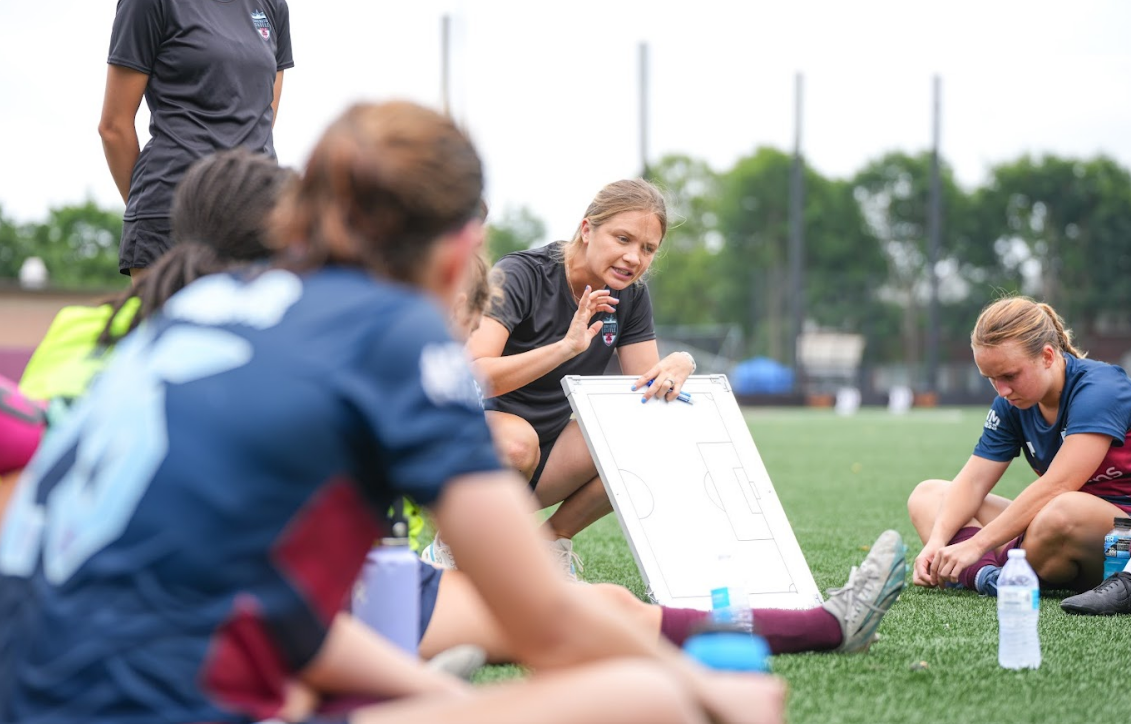
You’re right in that there is just a lot of excitement in the Midwest for women’s soccer. It’s going to be so much fun to play away. Some of my favorite moments in our history as a club have been watching the women’s team kick ass. The players and their head coach, Emma Woodley, have created such a good culture, worked so hard, and have built a community within that program.
Last season, Emma’s coaching staff was composed of three former players. Our women’s program director, Nicole D’Agustino, was a longtime goalkeeper for us. They’re a group of people who are really good at what they do – they’re passionate about it and know how to succeed together.
We’re so lucky that we have people like that. With the women’s program specifically, they’ve taken this team and made it so positive and joyful – a thing that people want to be a part of. Going into the W League and giving that a higher platform is something that I’m excited to see.
Kellyn Acosta is someone that the average American soccer fan probably knows by name, and he’s been with the Chicago Fire for a few years now. How did he get involved, and how is he helping you to grow?
It’s a big deal for the team for obvious reasons. He’s a long-time pro in the US. Obviously, he played in the World Cup not too long ago. The main thing is he’s a guy who really cares about the community.
It basically started when I sent him a “welcome to Chicago” DM when he signed with the Fire, like everyone did. I was so excited! There was some fuzzy picture of him on a sideline in preseason, and everyone was like, is that him? Like everyone else, I was super-pumped, and I messaged him, “Hey man, I’m super excited you’re joining. I know you’re really into doing community engagement stuff. I’m a part of this club that I started. I’d love to tell you about it,” and that went undetected for months. Then I responded to another thing he had posted and he saw the previous message.
I thought it was very cool of him to even respond, and we started talking about the club. We got on a phone call, I invited him out to a training for the women’s team. We talked about the history of the club, what our mission is, and what we’re up to. As time went by, he was more curious about how things worked and wanted to see under the hood. Once we were seeking out people to get involved in the club’s leadership and ownership, I brought it up and he was receptive to it.
That was the luckiest thing ever. It’s turned into a collaborative working relationship between him and me. Kellyn participated in our release video as our leading man. He’s helping us with a lot of conversations with other sports companies, trying to get us acquainted with professional spaces in the game. He’s been a huge boon to the club.
As we’re in the process of trying to convince people that we’re serious and we’re not going to waste their time and money, having someone you’ve heard of say, “I’m doing this,” is really nice for that. I owe Kellyn a lot for being the good dude he is and being willing to believe in us. Our whole story is about people believing in it and wanting it to work. The fact that Kellyn came on and believes in it means a ton to everyone at the club.
We’re in this era where the USL is growing like a weed, and there’s an ambition for a promotion-relegation system. Do you see the future of Edgewater Castle at the fully professional level? If not, what is the long-term goal?
As the landscape has changed across U.S. soccer, we’ve evolved with that. We were founded in 2017, basically the day before that game where the U.S. didn’t make the World Cup. There was already a ton of ire in the culture prior to that moment, but when it happened, there were bigger questions. What is our grassroots culture like? Is that the problem?
A ton of clubs started in that period at the amateur or semi-pro level. Now, we’ve reached a point where our model has proven to be pretty sustainable. As we’ve grown and what we offer has grown with us, we’ve now been met with the opportunity to be involved in the USL.
Our ambition is higher now than it was a couple years ago. That involves being a part of those stories that I was mentioning. The storytelling of soccer that captures people – though it may be taking place elsewhere – is the idea of climbing through a meritocracy, right? It’s the idea of being able to win despite vast differences in funding. There’s something about what we’ve built that lends itself to that kind of story, especially given our model.
We don’t know exactly when we’ll be ready to do that. We do have an ambition to try, certainly. How soon we’re able to, I don’t know! Eventually, in the correct amount of time it takes for us to get there, we want to become a professional club altogether.
This interview has been lightly edited for clarity and concision.
Photo credit to Nicholas Balabanoff (Cover/Body, #1); Ruben Urquiza (Body, #2).


